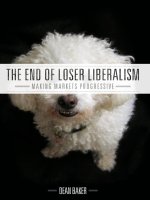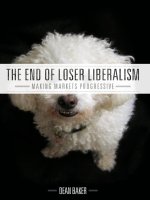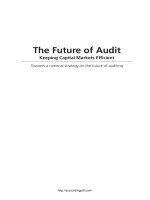The End of Loser Liberalism: Making Markets Progressive pot
Bạn đang xem bản rút gọn của tài liệu. Xem và tải ngay bản đầy đủ của tài liệu tại đây (1.54 MB, 171 trang )
The End of Loser Liberalism
Making Markets Progressive
By Dean Baker
Published by the Center for Economic and Policy Research
Washington, DC
Published by the Center for Economic and Policy Research
1611 Connecticut Ave. NW, Suite 400
Washington, DC 20009
www.cepr.net
Cover photo by Helene Jorgensen
Cover design by Justin Lancaster
Creative Commons (cc) 2011 by Dean Baker
Notice of rights: This book has been published under a Creative
Commons license. This work may be copied, redistributed, or
displayed by anyone, provided that proper attribution is given.
ISBN: 978-0-615-53349-0
Contents
Contents iii
Acknowledgments v
1 Upward Redistribution of Income: It Didn’t Just Happen 1
2 The Economic Crisis: Where We Are and How We Got Here 13
3 The Great Redistribution 29
4 The Bubble Economy 38
5 Fulcrums of Power I: The Fed and Interest Rates 53
6 Full Employment without the Fed 65
7 Fulcrums of Power II: The Treasury and the Dollar 84
8 Trade in an Overvalued-Dollar World 92
9 Reining in Finance 117
10 Government-Granted Monopolies Are Not Small Government . 136
11 Follow the Money: The Guiding Light for a Progressive Strategy 148
References 156
Acknowledgments
I have benefitted enormously from discussing the ideas in this book with my
colleagues at the Center for Economic and Policy Research, Eileen
Appelbaum, Heather Boushey, Helene Jorgensen, David Rosnick, John
Schmitt, and Mark Weisbrot. I also received helpful comments on the
manuscript from Alan Barber, Kris Warner, and Nicole Woo. Jane Farrell
helped with the graphs. Pat Watson did his usual outstanding job editing the
book.
I thank Helene, Walnut, Olive, and Kiwi for tolerating my neglect
while writing the book. And Biscuit deserves special note for allowing himself
to be the poster boy of Loser Liberalism.
The End of Loser Liberalism: Making Markets Progressive
1
Chapter 1
Upward Redistribution of Income:
It Didn’t Just Happen
Money does not fall up. Yet the United States has experienced a massive
upward redistribution of income over the last three decades, leaving the bulk
of the workforce with little to show from the economic growth since 1980.
This upward redistribution was not the result of the natural workings of the
market. Rather, it was the result of deliberate policy, most of which had the
support of the leadership of both the Republican and Democratic parties.
Unfortunately, the public and even experienced progressive political
figures are not well informed about the key policies responsible for this
upward redistribution, even though they are not exactly secrets. The policies
are so well established as conventional economic policy that we tend to think
of them as incontrovertibly virtuous things, but each has a dark side. An anti-
inflation policy by the Federal Reserve Board, which relies on high interest
rates, slows growth and throws people out of work. Major trade deals hurt
manufacturing workers by putting them in direct competition with low-paid
workers in the developing world. A high dollar makes U.S. goods
uncompetitive in world markets.
2
Dean Baker
Almost any economist would acknowledge these facts, but few
economists have explored their implications and explained them to the general
public. As a result, most of us have little understanding of the economic
policies that have the largest impact on our jobs, our homes, and our lives.
Instead, public debate and the most hotly contested legislation in Congress
tend to be about issues that will have relatively little impact.
This lack of focus on crucial economic issues is a serious problem from
the standpoint of advancing a progressive agenda. Mainstream economic
conservatives already have an enormous advantage in national politics because
they control most of the money that finances political campaigns. To add to
that, they also use their money to buy directly into the national debate by
funding organizations and projects intent on undermining important programs
they don‟t like – as investment banker Peter Peterson has done with his
decades-long crusade against Social Security and Medicare. But all the money
in the world will hardly matter if progressives do not understand how basic,
conventional economic policy militates against the interests of working people
and the disadvantaged. If they don‟t even know what winning would look like,
then the prospects for a progressive economic agenda are bleak.
For the most part, progressives accept the right‟s framing of economic
debates. They accept the notions that the right is devoted to the unfettered
workings of the market and, by contrast, that liberals and progressives are the
ones who want the government to intervene to protect the interests of the
poor and disadvantaged.
But this view is utterly wrong as a description of the economy and
competing policy approaches. And it makes for horrible politics. It creates a
scenario in which progressives are portrayed as wanting to tax the winners in
society in order to reward the losers. The right gets to be portrayed as the
champions of hard work and innovation, while progressives are seen as the
champions of the slothful and incompetent. It should not be surprising who has
been winning this game.
In reality, the vast majority of the right does not give a damn about
free markets; it just wants to redistribute income upward. Progressives have
been useful to the right in helping it to conceal this agenda. Progressives help
to ratify the actions of conservatives by accusing them of allegiance to a free-
market ideology instead of attacking them for pushing the agenda of the rich.
The End of Loser Liberalism: Making Markets Progressive
3
For the last three decades the right has been busily restructuring the
economy in ways that ensure that income flows upward. The rules governing
markets, written by the rich and powerful, ensure that this gravity-defying
outcome prevails. The right then presents the imposition of rules that it likes
as the natural result of unfettered market forces.
Rarely does this upward flow of income require a government check
to the wealthy. But when the checks are necessary, they come. The Treasury
and the Federal Reserve Board gave trillions of dollars in loans, at below-
market interest rates, to the largest Wall Street banks at the peak of the
financial crisis in 2008. These loans kept Goldman Sachs, Citigroup, and most
of the other major Wall Street banks from collapsing, and the subsidies
implied by the loans and guarantees to the world‟s largest banks were in the
tens if not hundreds of billions of dollars. Yet somehow this massive
intervention on behalf of these banks‟ executives, shareholders, and
bondholders – some of the richest people in the country – is not viewed as
interference with the market.
1
While the bank bailouts were big news, there is no shortage of less-
visible instances in which conservatives have long been eager for the
government step in to support the interests of the wealthy. We‟ll quickly
discuss seven examples here: continued support for too-big-to-fail banks,
patent and copyright protection, restrictions on organized labor, corporate
liability limitations, Federal Reserve monetary controls, trade and dollar
policy, and housing policy.
Too-big-to-fail banks
To start with an easy one, how many “free market fundamentalists” have
rallied behind efforts to break up “too-big-to-fail” banks? This one should be a
no-brainer for any genuine believer in free markets. A too-big-to-fail bank is a
1
Supporters of the bailout have been eager to claim that the government made money on
these loans. This is not honest accounting. The money was lent at rates far below the market
rate at the time. No accountant would ever say that a below-market loan turned a profit
because it was repaid. Providing a loan at below-market rates implies a government subsidy,
and while Wall Street banks were able to get this subsidy from the government, millions of
struggling small businesses across the country were not so lucky.
4
Dean Baker
bank that everyone expects will be bailed out by the government if it gets in
trouble, as happened in 2008. Because investors can assume that the
government will back up the bank, they are willing to lend it money at a lower
interest rate than if they thought the bank was standing on its own. How could
any believer in the virtue of free markets support the existence of large
financial institutions that borrow at a lower cost than their competitors
because of an implicit guarantee from the government?
The fact that most of those claiming to be “free marketers” have
overwhelmingly been on the side of the too-big-to-fail banks tells the world as
clearly as possible that their motivations have nothing to do with a
commitment to market fundamentalism and everything to do with a
commitment to serving the interests of the rich and powerful. This is disguised
as a commitment to the market for the obvious reason that doing things out of
a commitment to free market principles sounds better than explicitly claiming
to pursue policies that redistribute income from the vast majority of the
population to the rich.
Patent and copyright protection
Patents and copyrights offer another example of how conservatives quietly
support massive intervention by the government. Though we tend to think of
them as integral parts of the free market, patents and copyrights are anything
but.
Patents and copyrights are both explicit government policies to
promote innovation and creative work. They reward inventors, musicians,
writers and other creative workers with government-enforced monopolies for
set periods of time, and these monopolies allow the holders to charge prices
far above the free-market price. For example, the nation will spend close to
$300 billion in 2011 on prescription drugs.
2
In the absence of government-
enforced patent monopolies, the same drugs would cost around $30 billion, an
amount that implies a transfer to the pharmaceutical industry of close to $270
billion a year, or about 1.8 percent of gross domestic product. It is close to 15
times current federal spending on the main government welfare program,
2
Center for Medicare and Medicaid Services (2011a), Table 11.
The End of Loser Liberalism: Making Markets Progressive
5
Temporary Assistance for Needy Families (TANF), and it dwarfs the money at
stake from a main goal of progressives: eliminating the Bush tax cuts for the
wealthy (Figure 1-1).
Copyright monopolies also involve massive transfers to companies like
Microsoft, Apple, Time Warner, Disney, and Sony because the monopoly
allows the companies to charge large sums for software, recorded music, and
video material that would be available at no cost in a free market. Free-market
fundamentalists should not be supporting this sort of interference in the
market.
Restrictions on organized labor
Yet another area where the government intervenes in the market at the behest
of the well-off to diminish the well-being of workers and the disadvantaged is
3,400
680
0
500
1,000
1,500
2,000
2,500
3,000
3,500
4,000
Free-market drugs Bush tax cuts for the wealthy
Billions of dollars
Figure 1-1. Potential savings from free-market
drugs vs. potential revenue from eliminating Bush
tax cuts for the wealthy, 2011-2020
Source: Savings from free-market drugs from the Center for Medicare and
Medicaid Services (2011b), assuming savings to be 90 percent of projected
expenditures. Potential revenue from Bush tax cuts comes from Department of
Treasury data as given by Tax Policy Center (2010).
6
Dean Baker
labor-management policy. The accepted view is that progressives want the
government to intervene to protect workers, while conservatives would rather
let workers and management sort things out for themselves. That‟s not quite
the story.
Though labor law provides protections to workers and their unions, it
also constrains workers‟ power in important ways. For example, it is illegal to
organize or honor a secondary boycott. If the workers at a restaurant go on
strike and then arrange for the Teamsters to refuse to deliver food to honor
the strike, the restaurant can enlist the government to deliver injunctions and
impose fines against the Teamsters. If Teamsters officials ignore the injunction
(e.g., they don‟t tell their members that they cannot refuse to deliver food to
the restaurant), they can face imprisonment.
3
This is not the free market; this
is the government intervening on behalf of employers.
Another example of how labor-management policy is rigged away
from market forces is the fact that 22 states currently deny workers freedom
of contract with their employers. Under “right-to-work” laws, workers are
prohibited from signing contracts with employers that require workers
covered by a union contract to pay their share of the union‟s costs. The law
requires that everyone who is in a union bargaining unit – regardless of
whether they are actually in the union – gets the same pay and benefits. The
law also requires that the union represent workers in disputes with employers
on issues covered by the contract, whether or not a worker is in the union.
This means that if a worker who does not pay to support the union is fired, the
law requires that the union represent the worker through any appeals process
established under the contract.
While the law requires unions to provide the same benefits to all
workers covered by a contract, right-to-work laws prohibit unions from
signing agreements with employers that would require workers to pay for the
benefits they are receiving. It in effect guarantees representation without
taxation. This restriction of freedom of contract is not consistent with a free
market. “Right-to-work” laws are just another way in which the right uses the
3
The Teamsters generally negotiate contracts that include a provision to the effect that they
do not have to cross a picket line if they fear for their personal safety. There have been many
incidents over the years in which truck drivers have feared for their safety upon seeing a
union picket line.
The End of Loser Liberalism: Making Markets Progressive
7
power of the state to reduce the power and income of workers. Free
marketers are perfectly willing to deny the freedom of contract to accomplish
this end.
Corporate liability limitations
The modern limited liability corporation is another example of interference
with a pure free market. Corporations do not exist in the natural world or in
the free market; they have to be chartered by a government. They are artificial
entities that can inflict damage on the public without the individuals at fault
being held fully accountable. Limited liability means that the government
allows corporations to harm individuals – for example, by allowing toxins to
get into a community‟s drinking water – without the corporation‟s top
management or shareholders being obligated to pay compensation. The victims
(those drinking contaminated water in this case) are entitled to whatever assets
are held by the corporation, but they cannot take the personal assets of the top
managers or the shareholders.
By creating limited liability corporations the government is allowing
the individuals who form a corporation to take the property (or even lives) of
others without compensation. This is not a free market.
Federal Reserve monetary controls
A government policy with tremendous influence over economic outcomes is
the power of the Federal Reserve Board in determining the level of
employment. The Fed can foster growth and employment with low interest
rates and expansionary monetary policy. But it can and often does deliberately
raise the unemployment rate by raising interest rates. Moreover, the Fed‟s
policy on holding assets like government bonds has an enormous impact on the
government‟s debt burden, which in turn has redistributive implications.
Yet Fed policy receives little attention from progressives. We spend
far more time arguing over jobs bills that will have a trivial impact on
employment compared to the Fed‟s monetary policy. And we devote major
8
Dean Baker
lobbying efforts to tax or budget items that don‟t have a tenth of the impact on
the debt as the Fed‟s decisions on its asset holdings.
4
Figure 1-2 shows the lost output from the Great Recession, an event
that could have been averted with competent Fed policy, compared with
revenue that would be gained over the years 2011-2020 from eliminating the
Bush tax cuts for the wealthy. As can be seen, the lost output from the Great
Recession is more than five times as large.
4
The Fed currently holds close to $3 trillion in mortgage-backed securities and government
bonds. As long as the Fed holds on to these bonds, the interest on these assets is refunded to
the Treasury: in 2010 the refund was almost $80 billion. By continuing to hold these assets
indefinitely, rather than selling them to the public (which would mean the Fed would no
longer be able to refund the interest), the Fed would substantially reduce the government‟s
interest burden in future years.
3,913
680
0
500
1,000
1,500
2,000
2,500
3,000
3,500
4,000
4,500
Lost output, Great Recession Bush tax cuts for the wealthy
Billions of dollars
Figure 1-2. Lost output from the Great Recession
vs. potential revenue from eliminating Bush tax
cuts for the wealthy, 2011-2020
Source: Lost output from the Great Recession comes from summing the gaps in
the Congressional Budget Office’s (CBO) estimates for potential GDP with the
historical and projected actual GDP: CBO (2011a), Table E-11 and Figure 2-14.
Bush tax cuts: Tax Policy Center (2010).
The End of Loser Liberalism: Making Markets Progressive
9
The right is happy to keep the Fed out of public debate since, as things
stand, the right largely controls it. Conservatives promote an image of the Fed
as an august institution, managed by high priests who are unsullied by the dirty
back-and-forth of partisan politics. This view works out great for
conservatives, since policy decisions by the Fed and for that matter other
central banks typically have far more impact on the economy than most of the
issues debated by Congress. The right manages to stir up big debates over
relatively small matters, leaving it to control one of the most important levers
of power in the economy. And this, the right would have us believe, is the
work of the free market.
Trade and dollar policy
Another example of an area in which the right has almost completely
controlled the debate, and therefore the policy outcome, is trade and dollar
policy. The right has pushed a trade (and immigration) agenda over the last
three decades that has had the explicit goal of putting non-college-educated
workers in direct competition with low-paid workers in the developing world.
The predicted and actual effect of this policy is to reduce the wages of non-
college-educated workers relative to the wages of more highly educated
workers and to increase corporate profits.
The trade deals negotiated over the last three decades have left highly
educated workers largely protected from this competition; the agreements
mostly focus on subjecting workers without college degrees to international
competition. This policy has been carried through under the guise of free
trade, but it has nothing to do with promoting free trade: a genuine free trade
policy would be designed to place all U.S. workers, not just those without
college educations, in competition with their lower-paid counterparts in the
developing world.
The value of the dollar is another key policy lever that has been largely
kept out of public policy debates. The Federal Reserve Board and the Treasury
have enormous ability to influence the value of the dollar. A high dollar makes
U.S. goods and services less competitive in the world economy. It makes our
exports more expensive to people living in other countries, and it makes
10
Dean Baker
imports cheaper for people in the United States. As a result, a high dollar will
reduce our exports and increase our imports, creating a trade deficit.
A trade imbalance matters hugely for the distribution of income in a
context where some workers are exposed to international competition and
others are protected. The high-dollar policy redistributes income from the
workers who are exposed to international competition (non-college-educated
workers) to those who are largely protected from such competition (primarily
highly educated professionals, like doctors and lawyers). The high dollar
means that the non-college-educated workers, in the face of competition from
lower-cost imports, have to work for less to keep their jobs. On the other
hand, those who are protected from this competition keep their good jobs and
salaries and get to buy lower-cost imported products.
Is dollar policy just an esoteric, econometric issue? Hardly. Moving
the value of the dollar up or down against other currencies by 10 percent has
the impact on U.S. employment and wages of a hundred North American Free
Trade Agreements. Yet how often might the dollar move that much without a
peep from the press or progressive policy makers?
Of course, the hand that controls dollar policy is not the invisible hand
of the free market. Business and financial interests have the upper hand at the
Treasury Department and the Fed, but almost no one is talking about this
important lever of economic power.
Housing policy
Though it is not hard to follow and appreciate Fed policy or the ups and downs
of the dollar, we ignore these important economic policies at our peril.
Instead, many progressives take the lead of conservatives and focus on the
easy-to-see ups and downs of the stock market as a measure of economic
health. Yet a mainstream economics textbook would tell us that the value of
the stock market is supposed to reflect the value of future corporate profits.
Rising profits could mean that future growth will be stronger and that wages as
well as profits will be higher. On the other hand, the stock market might rise
because investors believe that profits will rise at the expense of wages, or as a
result of lower corporate tax payments. In the latter, redistributive case, only
those who hold lots of stock would have reason to be happy about the prospect
The End of Loser Liberalism: Making Markets Progressive
11
of higher stock prices. Higher stock prices ought not to provide any more
cause for celebration than higher corn or zinc prices – it‟s good news for corn
and zinc producers, but bad news for everyone else. Thus, there‟s little benefit
from rising stock prices to give progressives cheer.
The same confusion about who benefits extends to rising home prices.
Higher home prices do not make society as a whole wealthier; they just
increase the share of society‟s wealth that can be claimed by homeowners.
Those who own the most expensive homes are the biggest gainers.
Since homeowners as a group tend to be wealthier than non-
homeowners, it is hardly progressive to support the upward redistribution of
wealth implied by higher home prices. Higher home prices also have the effect
of making it more expensive for current renters to become homeowners. In
other words, a policy that leads to higher home prices can be thought of as an
unaffordable housing program, a plan for an upward redistribution of income
that is 180 degrees at odds with progressive policy.
Most economists, even progressive ones, would no doubt take the
arguments presented above in different directions – for example, by arguing
that the Fed must restrain employment growth to keep inflation in check, or
that patent policy is essential to promote the development of new drugs. But
they would not dispute the basic points: the Fed indeed has enormous ability
to influence the economy through its control of interest rates and patents are
government-granted monopolies that cause drugs and other items to sell for
prices far above the free-market price.
If progressives can come to grips with the basic economics of the big
issues of the day, then it will at least be possible to make real progress in policy
debates. Without this knowledge, it is impossible to even know when progress
is being made. When progressives applaud a run-up in the stock market, as
many did in the Clinton years, they are rooting for the other team. When
progressives devise policies to keep a housing bubble from deflating, they are
plotting to use taxpayer dollars to allow the better-off segment of society to
benefit at the expense of the less-well-off, the ones who don‟t own homes or
own homes of little value.
The political system and the “free market” are rigged to the advantage
of the rich and powerful, which makes it difficult for progressives to make
12
Dean Baker
headway in pushing policies that advance the interests of everyone else.
However, this mission goes from difficult to achievable if we pay attention to
the basic economics. There are enormous obstacles in our path, but if we
don‟t know where we are going, then we can be absolutely sure that we are
not going to get there.
The End of Loser Liberalism: Making Markets Progressive
13
Chapter 2
The Economic Crisis:
Where We Are and How We Got Here
There is no cause for progressives to be on the defensive as the United States
and most other wealthy countries struggle to recover from the worst
downturn since the Great Depression. The economic disaster was entirely the
result of conservative economic policies, pursued with reckless abandon. If a
progressive government had driven the economy off a similar cliff,
progressives could expect to spend at least 40 years in the political wilderness.
No one would want to go near such discredited policies.
But progressives are on the defensive. A reinvigorated right is openly
attacking Social Security and Medicare, looking to take back economic gains
that date from the New Deal. It is also doing everything in its power to
undermine unions in both the public and private sectors because it recognizes
their importance as bulwarks of the Democratic Party and progressive politics
more generally. It is even taking steps to roll back the right to vote by pushing
measures that will make it more difficult to vote and will explicitly
disenfranchise particular groups of people.
How could progressives have allowed themselves to be beaten back?
The root of the problem is that President Obama and the leadership of the
14
Dean Baker
Democratic Party backed away from telling the truth about the economic
collapse. By refusing to “demonize” Wall Street and the rest of the financial
industry for the damage inflicted on the economy and the nation, the president
and his party left a huge void that has been filled with alternative stories.
Those who rely on the Washington Post and National Public Radio for
their news might think that the economy fell into this downturn because
reckless government spending sent financial markets into a panic, causing
businesses to lay off millions of workers. They are also likely to believe that
there will be no hope of recovery until the president and Congress agree on a
credible plan to bring spending under control in the decades ahead.
The truth is, this story makes as much sense as blaming the downturn
on an attack by space creatures, but in Washington debates it is not necessary
that a narrative be grounded in reality. Despite the fact that the budget deficit
holds center place in news accounts, it is not the cause of the economy‟s
current problems. The large deficit is rather the result of the economic
downturn that began in late 2007, a fact that can be easily shown by examining
the Congressional Budget Office‟s analysis of the budget, as shown in Figure
2-1.
5
Going into the downturn in 2007, the budget deficit was a relatively
modest 1.2 percent of GDP, and it was projected to get smaller in the years
ahead. It is arguable that even the 2007 deficit was too large – that with the
economy near full employment the government should have been running
budget surpluses – but it would be a stretch to equate a deficit equal to 1
percent of GDP with runaway borrowing that poses a threat to the
government‟s finances.
The downturn increased the deficit for two reasons. First,
government tax revenue and spending responds automatically to a weakening
economy. When the economy slows, the government takes in less money in
tax revenue. Unemployed workers stop paying Social Security taxes and pay
less in income tax. In addition, a higher rate of unemployment means that
more money will be paid out in various forms of benefits like food stamps and
unemployment insurance. Although budget deficits increase every time we
5
The annual budget projections from the Congressional Budget Office, along with regular
updates, are available at
The End of Loser Liberalism: Making Markets Progressive
15
have a recession, the increase this time was larger than most because of the
severity of the downturn.
The other reason that the deficit increased in the downturn was that
the government enacted various stimulus packages to boost the economy. It is
possible to identify at least three distinct stimulus packages since the downturn
began. The first consisted primarily of a tax cut. President Bush signed this
package into law in February 2008 at a time when the unemployment rate was
just 4.8 percent. President Obama proposed the second package just as he was
taking office in January 2009, and Congress approved roughly $700 billion in
new tax cuts and additional spending, mostly over calendar years 2009 and
2010.
6
The third stimulus, approved at the end of 2010 at a point when most
6
This stimulus package also included roughly $80 billion for a fix to the alternative minimum
tax (AMT) that prevented it from raising taxes on millions of middle-income families. This
fix really should not be included as part of the stimulus because it is a measure that Congress
16
Dean Baker
of the money from the second stimulus had been spent, extended President
Bush‟s 2001 tax cuts for another two years, reduced the payroll tax by 2
percentage points for a year, and continued extended unemployment benefits
through 2011.
These stimulus packages were explicitly designed to offset the effect of
reduced private-sector spending. The resulting rise in the deficit stemming
from the stimulus packages was not an accident – it was a deliberate goal of the
policy. Together the packages added more than $1.5 trillion to the deficits
over the fiscal years 2008-2011. However, the spending almost certainly
boosted the economy; it increased growth and created jobs.
7
A smaller deficit
in these years would have meant slower growth and fewer jobs. In this sense,
the deficit is part of the solution, not the problem.
If the deficit were impeding the economy‟s recovery, it would be
through its effect on the interest rate. This is the story of government
borrowing pulling money away from the private sector. However, the interest
rate on long-term bonds has remained extraordinarily low throughout this
period. At the height of the financial crisis, when investors fled to U.S. bonds
as a safe asset in a dangerous world, the interest rate on 10-year Treasury
bonds hit a low of 2.2 percent. It has remained under 4.0 percent since then
and in the summer of 2011 was back down to about 2.2 percent when the
threat of the break-up of the euro again panicked financial markets and has
been close to 3.0 percent most of the time.
Assuming a 2.0 percent expected inflation rate puts the real interest
rate (the actual interest rate minus the inflation rate) at under 2.0 percent and
has passed every year for two decades. No one ever expected to pay the higher AMT rate, so
preventing this tax increase from going into effect could not have provided a boost to
anyone‟s consumption.
7
See Blinder and Zandi (2010), CBO (2011a), and Feyrer and Sacerdote (2011). It is
important to point out that the Feyrer and Sacerdote study almost certainly understates the
job impact of the stimulus because it looks exclusively at in-state effects. Much of the
employment impact of stimulus spending is likely to spill across state lines. For example,
spending on a major construction project in Manhattan is likely to involve subcontractors
located in New Jersey. The materials are also likely to come at least in part from out of
state. Furthermore, when workers on the project spend their wages, they will be creating
jobs in other states if they don‟t live in New York. For these reasons a study such as this that
only picks up the in-state effects will substantially understate the full jobs impact of the
stimulus.
The End of Loser Liberalism: Making Markets Progressive
17
often under 1.0 percent for these high-deficit years (Figure 2-2). This is a
historically low real interest rate that is not consistent with a story of investors
panicking over the ability of the U.S. government to repay its debt. When
lenders worry about the solvency of their borrowers, they demand real
interest rates of 6, 8, or even 10 percent.
If investors are willing to hold vast amounts of government bonds at
very low interest rates, it is clear that the people who actually have money on
the line are not worried about the creditworthiness of the U.S. government,
even if the politicians and the pundits are telling them that they should be. In
short, the deficit is not the country‟s problem right now. The problem is a lack
of demand, pure and simple. The deficit is hyped as a problem by people who
have an alternative agenda of gutting important government social programs,
such as Social Security and Medicare.
-2
0
2
4
6
8
10
12
14
16
1981 1986 1991 1996 2001 2006
Percent
Figure 2-2. Interest rate for 10-year Treasury
bonds, 1981-2010
Source: Board of Governors of the Federal Reserve System
( and Bureau of Labor
Statistics (
Nominal Interest Rate
Real Interest Rate









